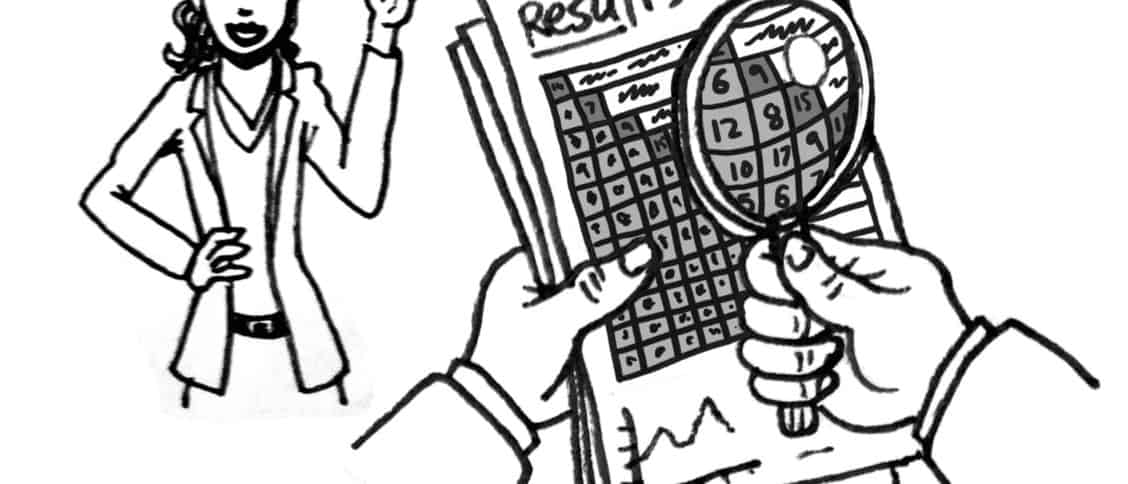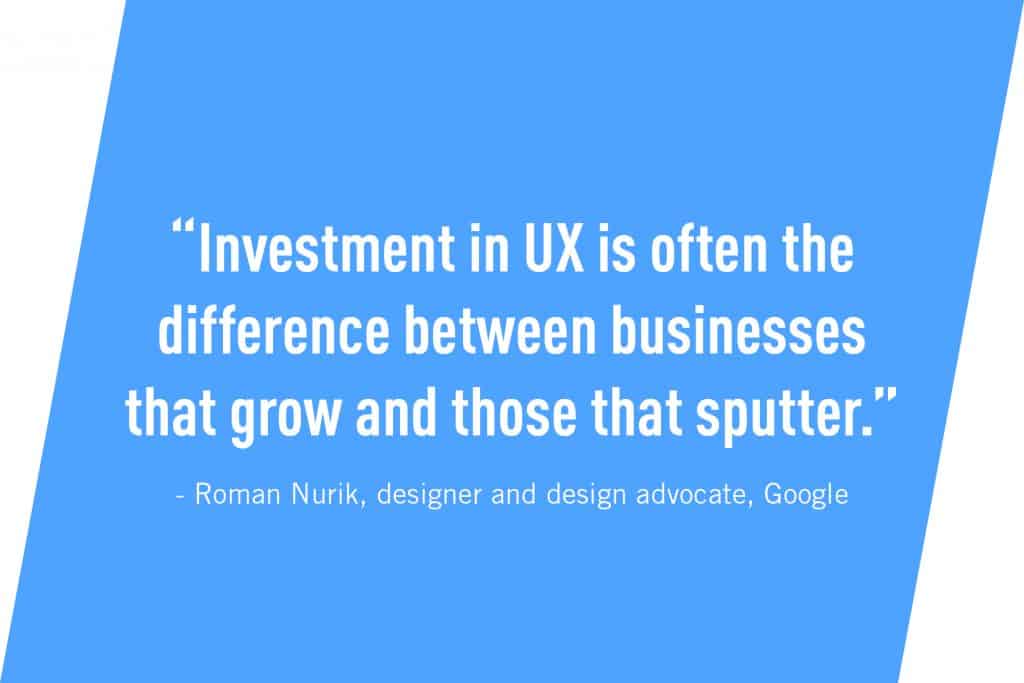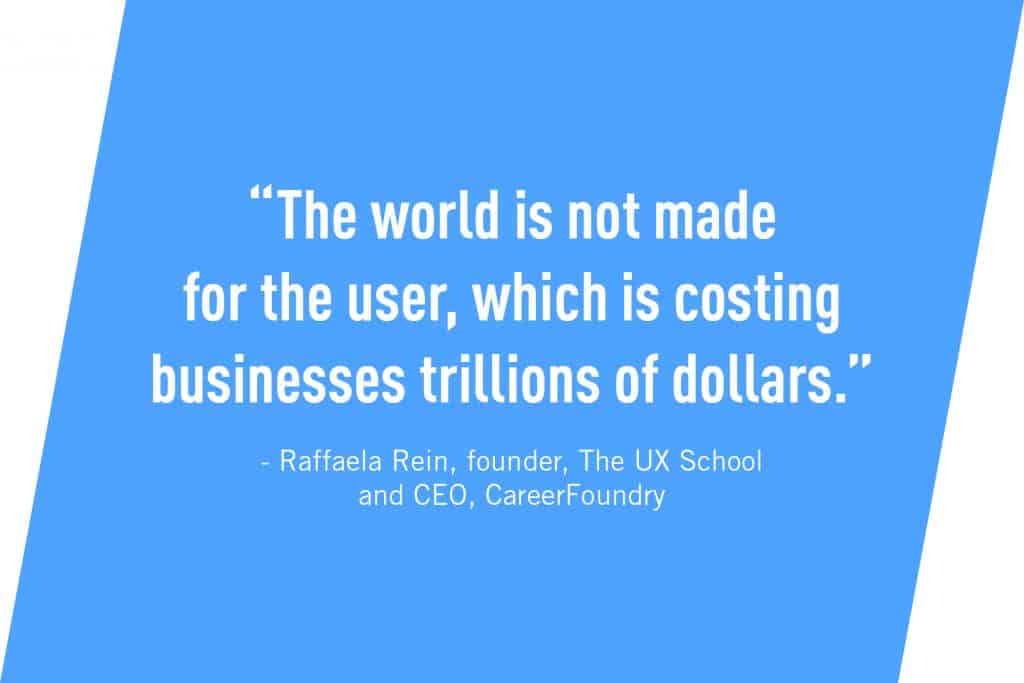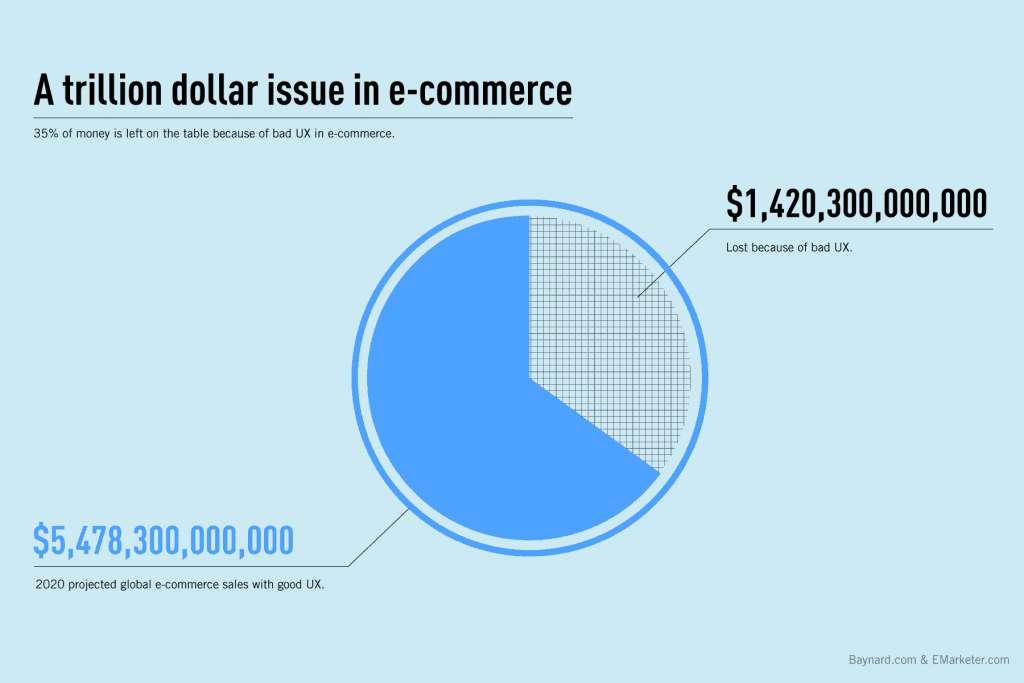As a UX designer, there are times when you need to prove to your employer or company stakeholders the value of what you do, and the difference it makes to your company’s bottom line. But many UX designers struggle to prove the value of their work.
That’s why The UX School put together a comprehensive report compiling the latest research in the ROI of UX design, with direct input from over 60 UX design experts from around the globe.
What did we find out?
We found out that UX design is so impactful for companies of every size that worldwide we are set to lose trillions of dollars per year in revenue by 2020 if companies continue to ignore the direct results of investing in UX.
Why is UX design becoming so powerful?
We have all become aware of the power we now have as users. Through social media and online reviews, we can be a lot more vocal about which products or services meet our needs and which fail to do so. Formerly a letter of complaint to a company would likely have fallen upon deaf ears (if it was written at all). These days however, a click of a button or a 140-character tweet is enough to not only complain about an experience but broadcast it to the world.
As the user’s experience becomes ever more transparent it is critical that organisations listen and respond to the user’s needs and wants. User-centric companies already do this, but they are currently still the minority.
In response to users’ growing online presence and the increased volume and importance of their voices, all companies will need to make this adaptation to survive. Investment in UX design will be the difference between category winners and losers, with the user experience becoming a product in itself. Companies which fail to invest in UX design won’t only lose money in the short term, they’ll fall behind their competitors and lose their customers.
In the report, we were able to pin down the financial wins of investment in UX design, as well as the enormous losses of not investing, so next time you need to prove your worth to your employer, you’ve got the figures to back you up.
Check out what we uncovered.
The financial impact of investing in UX
When we took a close look at the studies around investment in UX design, as well as the opinions and feedback of over 60 UX design professionals who we interviewed about it, it became abundantly clear that companies of all shapes and sizes benefited significantly from investment in UX. Even small investments in UX design yielded positive monetary results.
One 2016 design study of 408 companies found that the higher the investment in UX, the greater the increase in sales, the higher their customer retention and customer engagement was, and the faster the company moved through its product cycles. Those companies which invested the most, and who considered themselves to be fully user-centric, saw their sales increase by a staggering 75%.
One of the main areas of saving that a UX focus brought about was development time. UX designers reduce the time developers need to re-work or ‘fix’ a product by up to 50%.
It seems obvious, but with a UX designer on board a product idea can be fully fleshed out, prototyped, reworked and tested before a developer has even come on board. As we all know, it is a lot cheaper to fix a product before implementation, than once development has started.
It also means that developers can spend their valuable time working on products through to completion, rather than reworking the same product over and over. In the same vein, we found that companies that invested in UX design were able to release their products earlier, giving them the edge in innovation and against the competition.
We found out that 70% of projects fail due to an inability of a company to either attract or retain users. UX designers improve navigation, ease of use, and ‘delightful’ interactions, resulting in lower bounce rates. Similarly, sales growth due to products being tailor-made with the user’s needs and goals in mind can be attributed to UX designers.
Some of the other key points our research uncovered were:
- For every dollar invested in UX design, a company can expect 100 dollars in return
- The top 10 companies leading in customer experience outperformed the S&P index with more than triple the returns of their peers.
- Other economic advantages of a UX-led company included lower cost of customer acquisition, lower support costs, increased customer retention and increased market share.
What companies lose by not investing in UX design
By far our biggest finding from our research was that if investment in UX design remains at the level it currently is, then globally we can expect a trillion dollar loss in revenue by 2020 in e-commerce alone.
How did we find this out?
We looked at a report from eMarketer, which stated that by 2020, e-commerce sales will grow to a global total of about $4.058 trillion. However the conversion rate for e-commerce could be improved by 35% simply through better checkout flow and design, another report found.
When we looked at this data together we were able to conclude that by 2020, if checkout flow and design isn’t improved in e-commerce on an industrial scale, we can expect a global loss of $1.420 trillion.
This is supported by the fact that 27% of US online shoppers have abandoned an order in the past quarter solely due to a “too long / complicated checkout process”, while 35% abandoned their order because they needed to create an account to continue.
Already, these companies could have saved millions of dollars through small UX design fixes that put user needs and goals first.
Conclusion
During the compilation of our report, The UX School learned that products and services worldwide are not being built for the user, despite the increasing power and influence the user now has.
Somewhere along the line, the user’s needs are being deprioritized and the goals of the business put first and foremost. Ironically, were this not the case, companies would save money, and significantly increase their revenue. Why? Because users whose needs are met and enjoy interaction with an interface are far more likely to complete transactions, recommend their friends, become loyal to a brand and, crucially, return.
If you’ve been looking for facts and figures to prove your value as a UX designer, download the full report here. Together, let’s make the world a more user-friendly place.
Do you have any tips for explaining the value of UX design to stakeholders? Let’s chat in the forums, or leave a comment.












Investing money in improving user experience is no more an option, it is a necessity. Liked the interesting stats and figures that you mentioned. Nowadays businesses are investing more and more money on latest techniques that boost users experience.